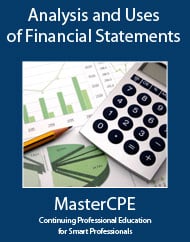Course Information
Analysis and Uses of Financial Statements
Course Information
| Title: | Analysis and Uses of Financial Statements |
|---|---|
| Category: | Accounting and Auditing |
| Field of Study: | Accounting |
| Course Code: | M251 |
| CPE Credits: | 10.0 |
| Price: | 69.95 |
Description
Description:
A series of recent business failures and corporate scandals where employees, investors, and other stakeholders suffered tremendous loss have made the world aware of the importance of proper recording of transactions and transaction analysis. If a company’s financial statements provide important insights into its financial health, such as financial position, growth potential, and profitability, the transactions must be analyzed and recorded in the accounts following generally accepted accounting principles.
Analysis and Uses of Financial Statements is designed for interested parties who must understand how to read, interpret, and analyze financial statements. This course describes in clear, concise, and understandable language the intricacies of financial statements, and their use by investors, creditors, analysts, and other interested parties. This course can enhance your chance for success in business and investing; by enabling you to profit from the knowledge, insights, and perceptions of professionals who use financial statement analysis tools and techniques on a day-to-day basis. Realistic examples, real-life cases, and illustrations of financial statement analysis are widely used in this course to make the subject matter crystal clear. That is the major objective of this course.
Delivery Method: Online Interactive Self Study
Level: Overview
Prerequisites: None
Advanced Preparation: None
Course Details
Category: Accounting and Auditing
Field of Study: Accounting
Passing Score: 70%
Technical Details: Accounting: Technical
For More Detail:
If you are unable to view PDF then right click the mouse and click save link as
Objectives
Objectives:
- Identify the underlying assumptions or concepts of accounting
- Recognize the major principles of accounting
- Identify key components of the FASB Conceptual Framework
- Recognize the importance of internal control over financial reporting
- Identify the objective of financial statements
- Recognize the use of interim financial statements
- Identify the balance sheet accounts portraying a company’s financial position
- Recognize the components of stockholders’ equity
- Identify the elements of the income statement
- Recognize the purpose of the statement of comprehensive income
- Identify the most important items on the statement of cash flows
- Recognize the importance of notes to financial statements
- Identify the annual report components
- Recognize common techniques used to manipulate financial statements
- Identify methods used in comparative analysis
- Recognize the basic components of ratio analysis
- Recognize and apply different liquidity ratios used to determine the ability to pay off current debt obligations
- Identify events that could affect a company’s liquidity
- Identify and apply ratios used to analyze a company’s capital structure
- Recognize key concepts of operating leverage
- Recognizes ways to evaluate a company’s quality of earnings
- Identify and apply key ratios related to profitability
- Identify and apply the major ratios used to evaluate the cash flow of a company
- Recognize the importance of earnings per share
- Identify and apply ratios used to measure market strength of a company
For More Objectives:
If you are unable to view PDF then right click the mouse and click save link as
Profession
NASBA: Yes
QAS: Yes
CPA: Suitable for all CPAs
IRS: No IRS credit for Enrolled Agents.
Profession Identifiers: CPA

